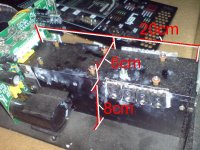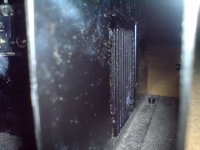Hi,
what do the internal fins look like?
Is the fan working efficiently at pushing cold air through the sink tunnel?
what do the internal fins look like?
Is the fan working efficiently at pushing cold air through the sink tunnel?
I guess this is not a heatsink. It's more likely looks as a piece of granit rock to be used as heatsink!
Btw, good idea, considering high prices for precious metals, granit electrical non conductivity there is no need to use any kind of washer only thermal compound!
One thing left to calculate a formula of its thermal conductivity to obtain a C\W ratings.
Btw, good idea, considering high prices for precious metals, granit electrical non conductivity there is no need to use any kind of washer only thermal compound!
One thing left to calculate a formula of its thermal conductivity to obtain a C\W ratings.
are the fan blades clean? Are the sink fins clean?The efficiency of the fan is 50%,and here is a picture of the fins
Are the inlet and outlet ports clean?
Is the oil in the fan bearing clean and to specification?
Are you still sure about your cooling efficiency?
Find out what the thermal resistance of it is, both the Cordell and Slone book tell you how. Here's a quick answer:
Get known value power resistors, and clamp it well to the heatsink
Dissipate a known power in the resistor for a long period of time. For your heatsink, you'd want to use multiple resistors on both sides to distribute the power like you will when you bolt a lot of output transistors to it.
Measure the temperature rise of the heatsink over the course of a few hours. Calculate C/W rise using the measurements of rise and power.
Determine how much output power you think you'll dissipate in the AV800 stage.
Figure out if you can live with the temp rise you'll have.
Get known value power resistors, and clamp it well to the heatsink
Dissipate a known power in the resistor for a long period of time. For your heatsink, you'd want to use multiple resistors on both sides to distribute the power like you will when you bolt a lot of output transistors to it.
Measure the temperature rise of the heatsink over the course of a few hours. Calculate C/W rise using the measurements of rise and power.
Determine how much output power you think you'll dissipate in the AV800 stage.
Figure out if you can live with the temp rise you'll have.
I do not think I know how to calculate C/W and the other stuff and I dont have how to calculate them picose i didn built the amp ,i will built it but first i need to make some money,I have the transformer suply capacitors pcb.
For andrewT everyting is clean , i aproximated the eficency by comparing the power of the air flow when the fan is in the air and mounted
I looked at specs from heat sinks that look similar and would guess this one could have something like 0.3 to 0.2 K/W which should be sufficient for an AV800 amplifier.
I'd give it a try.
Just my opinion.
I'd give it a try.
Just my opinion.
- Status
- Not open for further replies.
- Home
- Amplifiers
- Solid State
- Is this a proper heatsink for AV800

